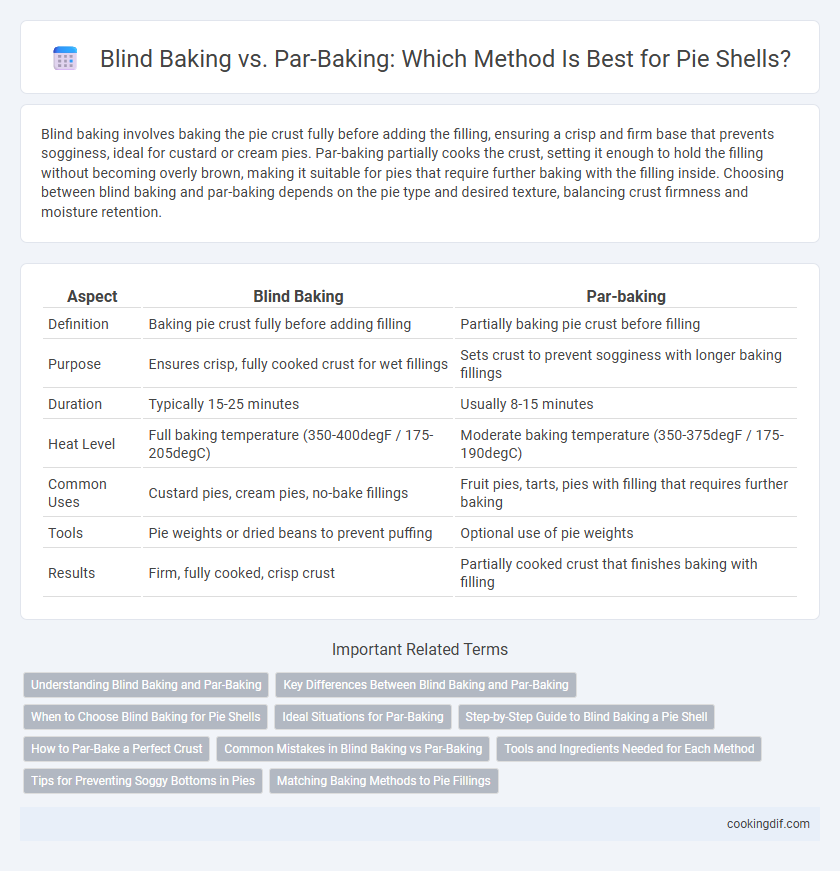Blind baking involves baking the pie crust fully before adding the filling, ensuring a crisp and firm base that prevents sogginess, ideal for custard or cream pies. Par-baking partially cooks the crust, setting it enough to hold the filling without becoming overly brown, making it suitable for pies that require further baking with the filling inside. Choosing between blind baking and par-baking depends on the pie type and desired texture, balancing crust firmness and moisture retention.
Table of Comparison
| Aspect | Blind Baking | Par-baking |
|---|---|---|
| Definition | Baking pie crust fully before adding filling | Partially baking pie crust before filling |
| Purpose | Ensures crisp, fully cooked crust for wet fillings | Sets crust to prevent sogginess with longer baking fillings |
| Duration | Typically 15-25 minutes | Usually 8-15 minutes |
| Heat Level | Full baking temperature (350-400degF / 175-205degC) | Moderate baking temperature (350-375degF / 175-190degC) |
| Common Uses | Custard pies, cream pies, no-bake fillings | Fruit pies, tarts, pies with filling that requires further baking |
| Tools | Pie weights or dried beans to prevent puffing | Optional use of pie weights |
| Results | Firm, fully cooked, crisp crust | Partially cooked crust that finishes baking with filling |
Understanding Blind Baking and Par-Baking
Blind baking involves pre-baking the pie crust without filling to ensure a crisp, fully cooked shell that prevents sogginess. Par-baking partially cooks the crust to set its structure while allowing it to finish baking with the filling, ideal for custard or cream pies. Mastering these techniques enhances pie texture and prevents undercooked or overly soggy crusts.
Key Differences Between Blind Baking and Par-Baking
Blind baking involves baking a pie crust without filling to ensure a crisp, fully cooked shell, often using pie weights to prevent puffing. Par-baking partially bakes the crust to set its structure while remaining soft enough to finish baking with the filling, avoiding sogginess. The key difference lies in blind baking's goal of a fully cooked crust before filling and par-baking's focus on a partially baked, flexible shell ready for final baking.
When to Choose Blind Baking for Pie Shells
Blind baking is essential when using wet or delicate fillings, such as custards or cream pies, to prevent a soggy pie crust by pre-baking the shell until it's crisp. Choose blind baking for recipes requiring a fully cooked crust before adding the filling, like chocolate silk pie or pumpkin pie. This technique maintains structural integrity and ensures a perfectly flaky texture without multiple baking stages.
Ideal Situations for Par-Baking
Par-baking is ideal for pies with wet or custard fillings that require a fully cooked crust without sogginess, such as pumpkin or chess pies. It is preferred when the filling cooks faster than the crust, ensuring the shell maintains structure and a crisp texture. This method suits pies baked at lower temperatures or with fillings that do not need further baking, preventing undercooked dough.
Step-by-Step Guide to Blind Baking a Pie Shell
Preheat the oven to 375degF (190degC) before lining the pie shell with parchment paper or aluminum foil, then fill it with pie weights or dried beans to prevent bubbling. Bake the shell for 15-20 minutes until the edges start to set, carefully remove the weights and lining, and bake for an additional 5-7 minutes until the bottom is golden and fully cooked. Cooling the shell completely before adding any filling ensures a crisp, flaky crust, essential for fruit pies or custard bases.
How to Par-Bake a Perfect Crust
Par-baking a pie crust involves baking the dough partially before adding the filling to ensure a crisp, fully cooked base. Begin by rolling out the dough, placing it in the pie dish, and chilling it for at least 30 minutes to prevent shrinkage. Next, dock the crust with a fork, line it with parchment paper, fill with pie weights or dried beans, and bake at 375degF (190degC) for 15-20 minutes, then remove weights and bake an additional 5-7 minutes until golden brown.
Common Mistakes in Blind Baking vs Par-Baking
Common mistakes in blind baking pie shells include failing to dock the dough or use pie weights, which leads to uneven rising and air pockets. In par-baking, over-baking or under-baking the crust results in a soggy or overly dry base that affects the final texture. Both techniques require precise timing and temperature control to ensure a properly baked, crisp pie crust.
Tools and Ingredients Needed for Each Method
Blind baking pie shells requires pie weights or dried beans to hold the crust's shape during baking, along with parchment paper or aluminum foil to cover the dough, preventing bubbling. Par-baking involves baking the crust partially without weights, often using egg wash or sugar sprinkled on the dough to create a barrier against sogginess once the filling is added. Both methods need a reliable pie dish and an oven, but blind baking demands additional tools like pie weights and protective liners for effective crust setting.
Tips for Preventing Soggy Bottoms in Pies
Blind baking pie shells with pie weights ensures an evenly cooked crust that resists sogginess when filled with moist ingredients. Par-baking partially cooks the crust, allowing it to set without browning fully, ideal for pies with custard or fruit fillings that release juice. Using a hot baking sheet and brushing the crust with egg wash or melted butter before baking creates a moisture barrier that helps prevent a soggy bottom.
Matching Baking Methods to Pie Fillings
Blind baking pie shells involves baking the crust fully before adding moist fillings, making it ideal for custards and cream pies to prevent sogginess. Par-baking partially bakes the crust, creating a sturdy base for fruit fillings that will continue cooking and release juices during baking. Choosing the correct method ensures optimal texture and prevents a soggy or undercooked crust by matching the crust's doneness to the filling's moisture and baking time.
Blind baking vs Par-baking for pie shells Infographic

 cookingdif.com
cookingdif.com